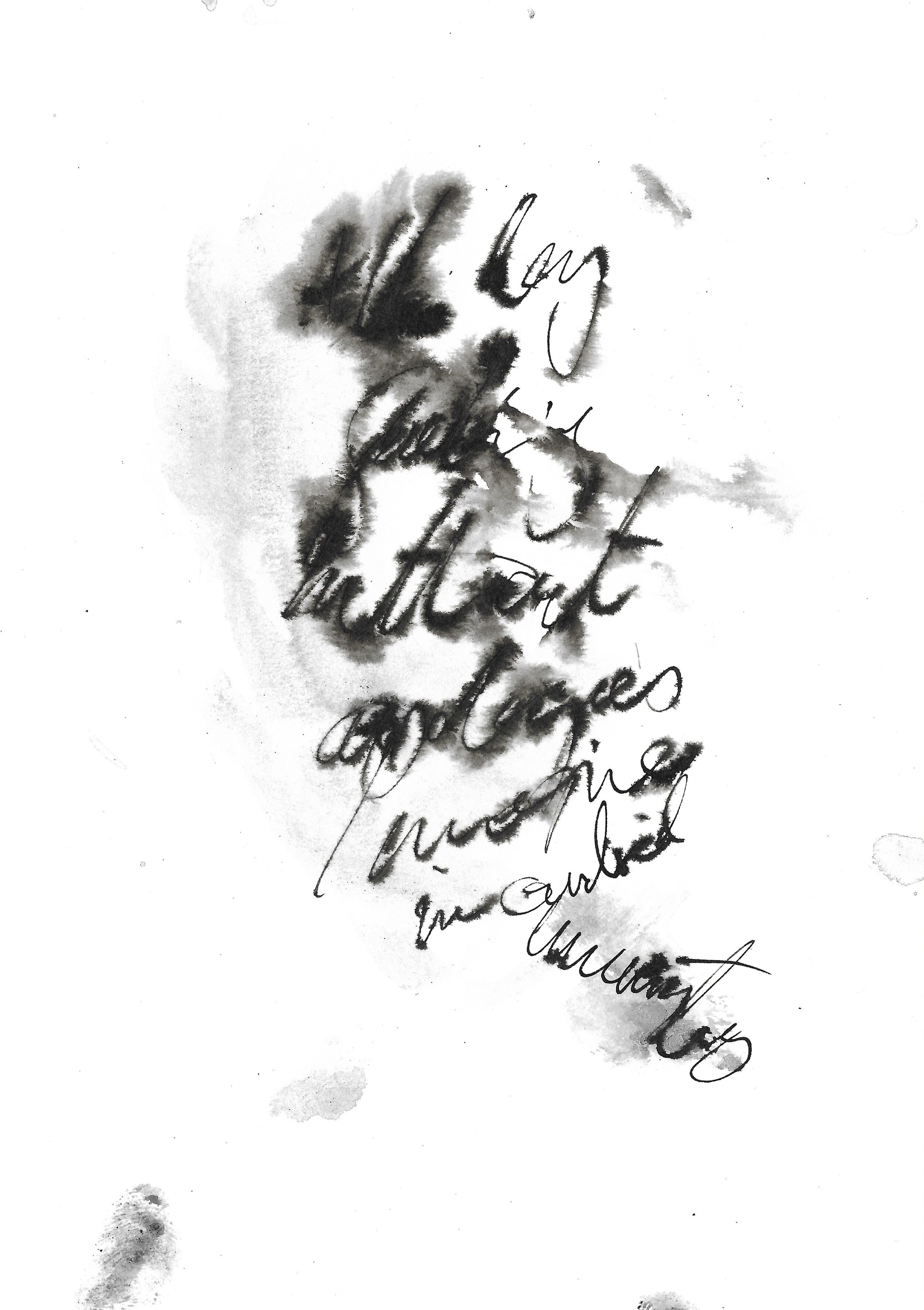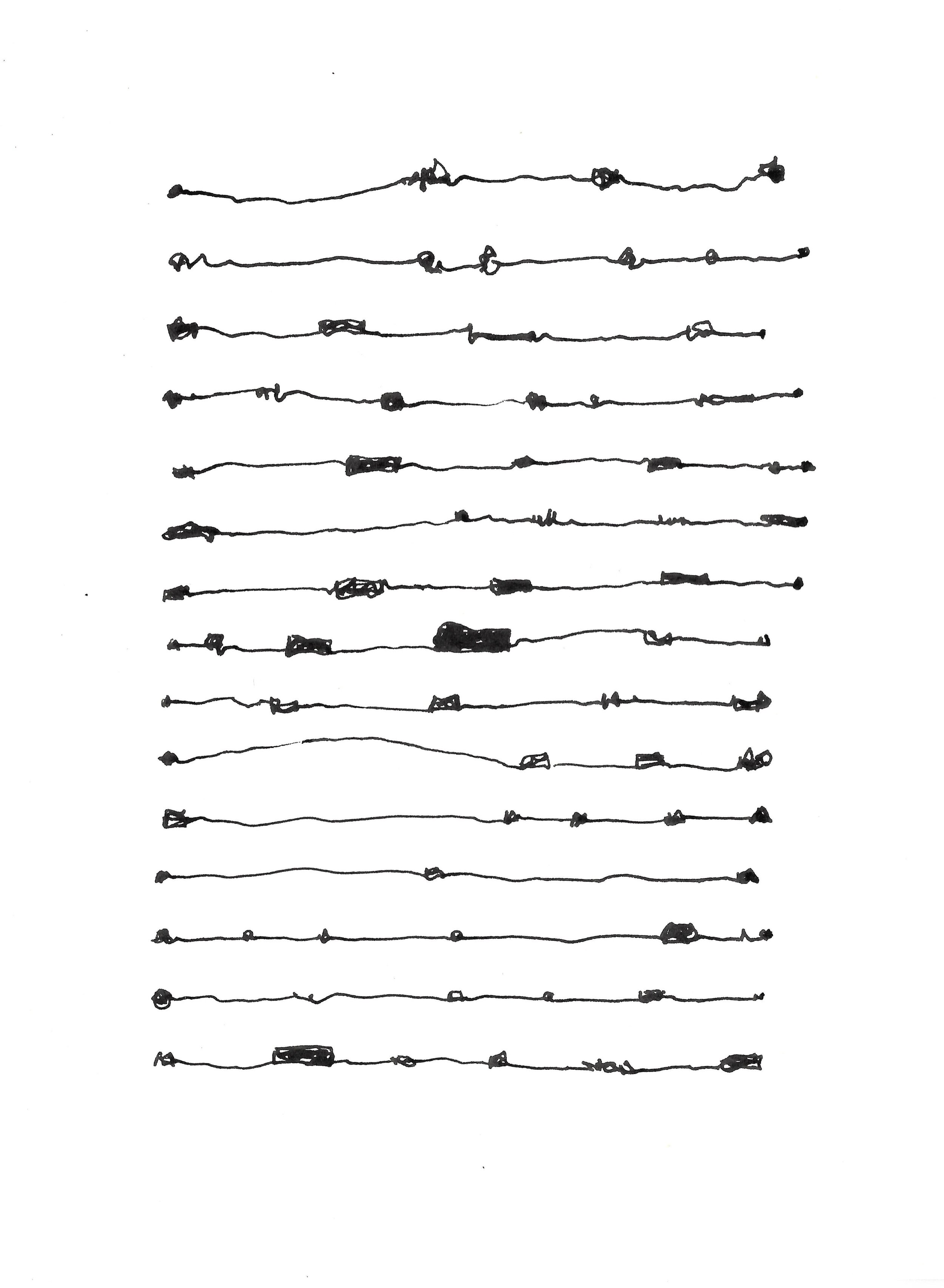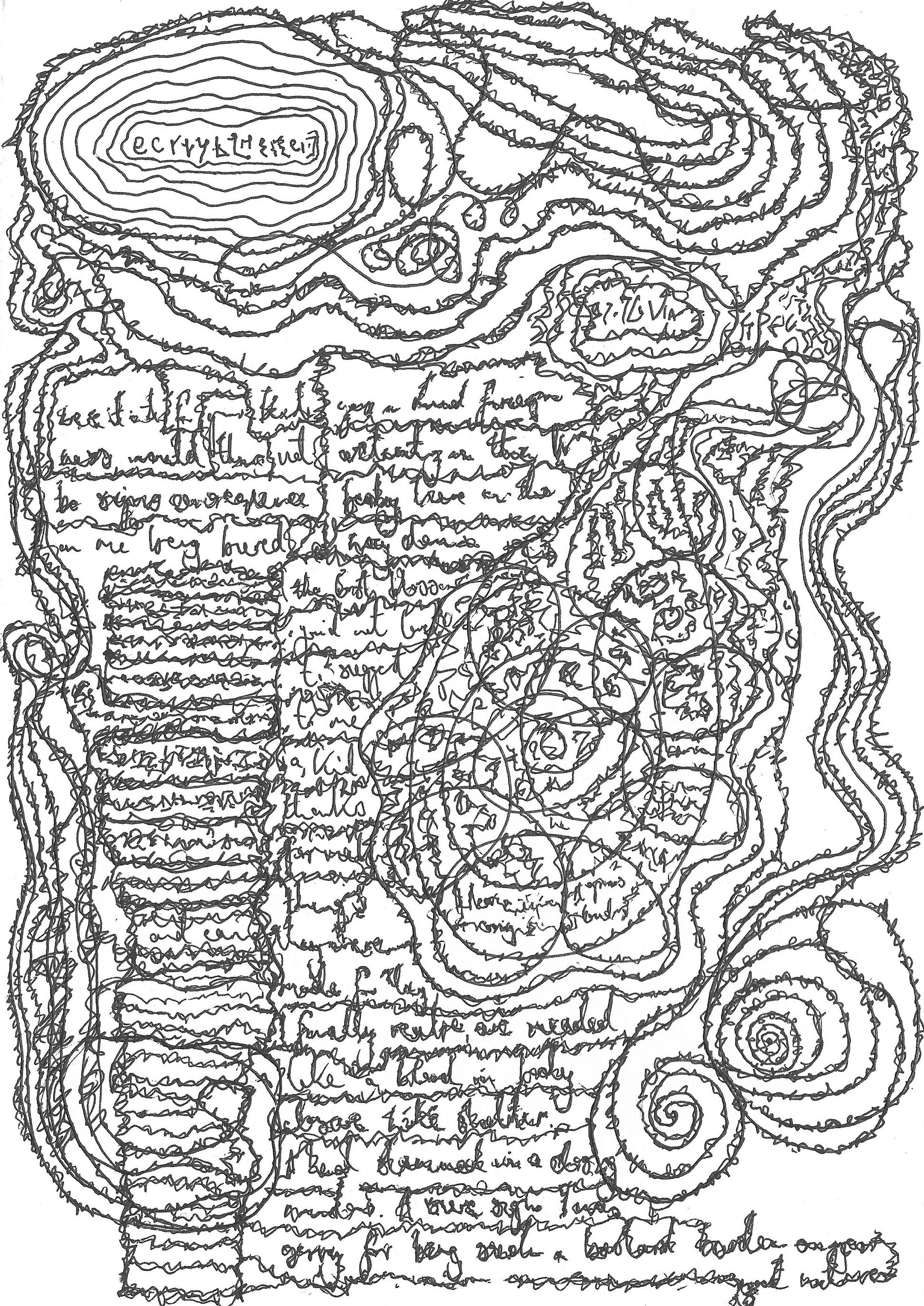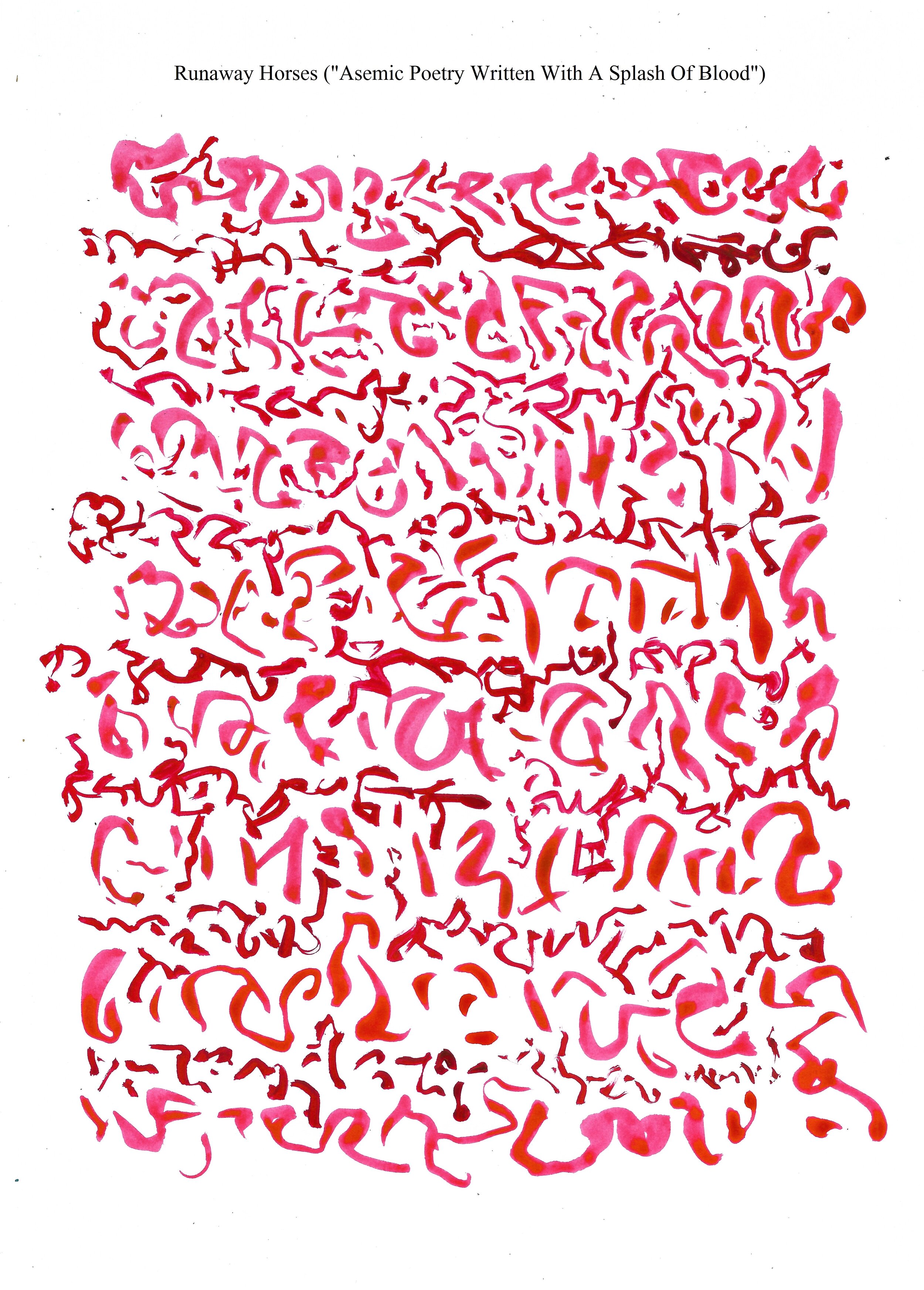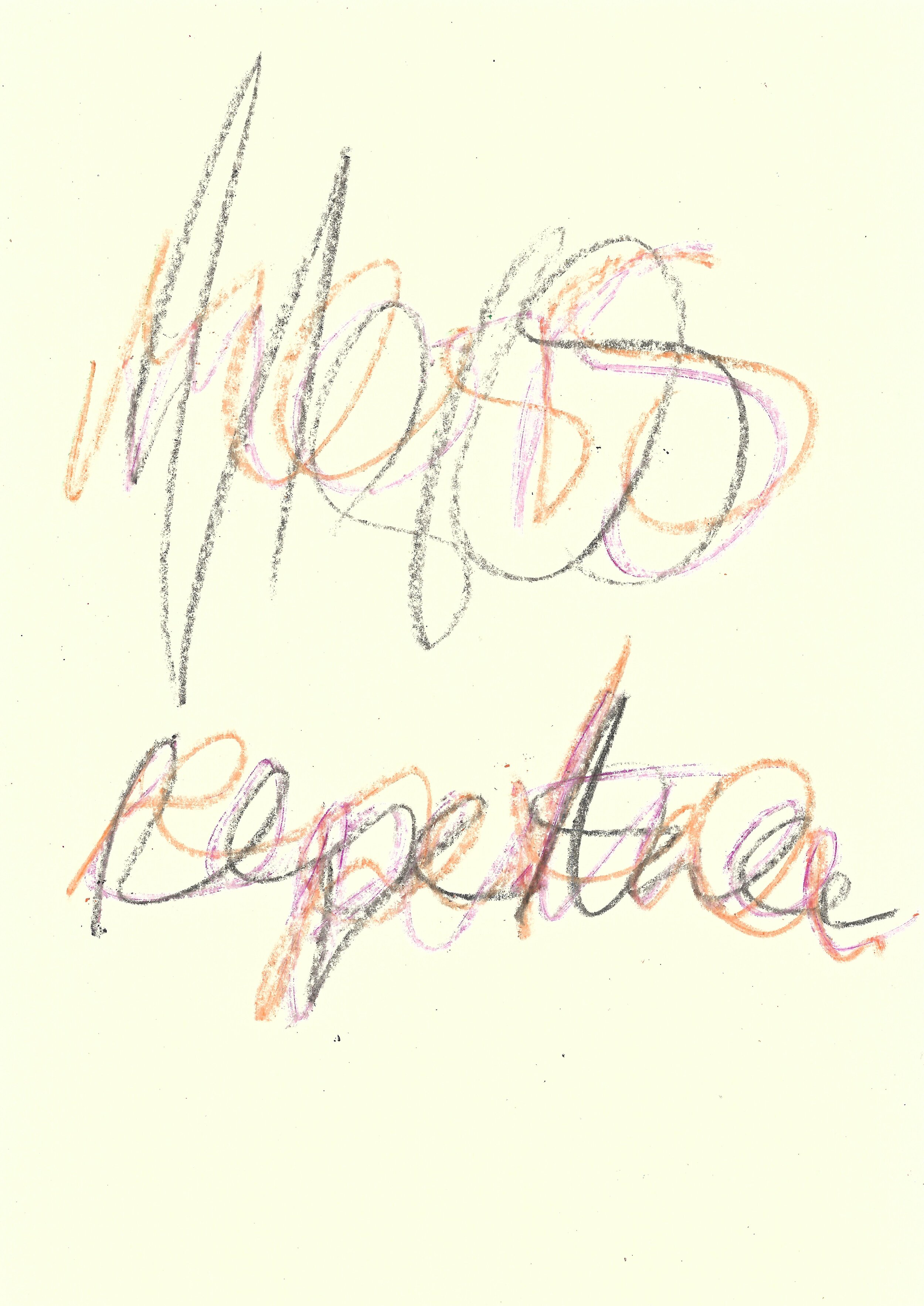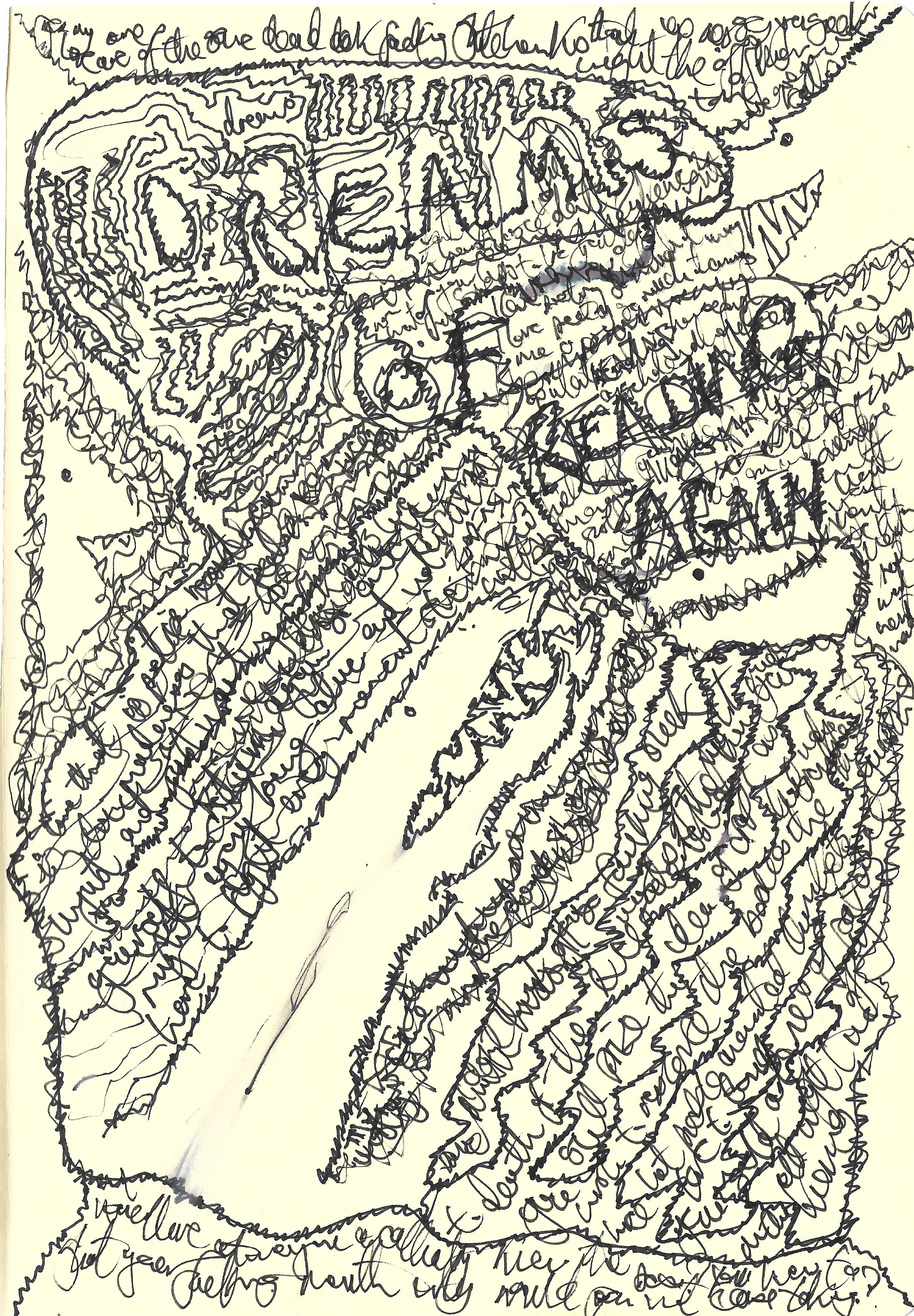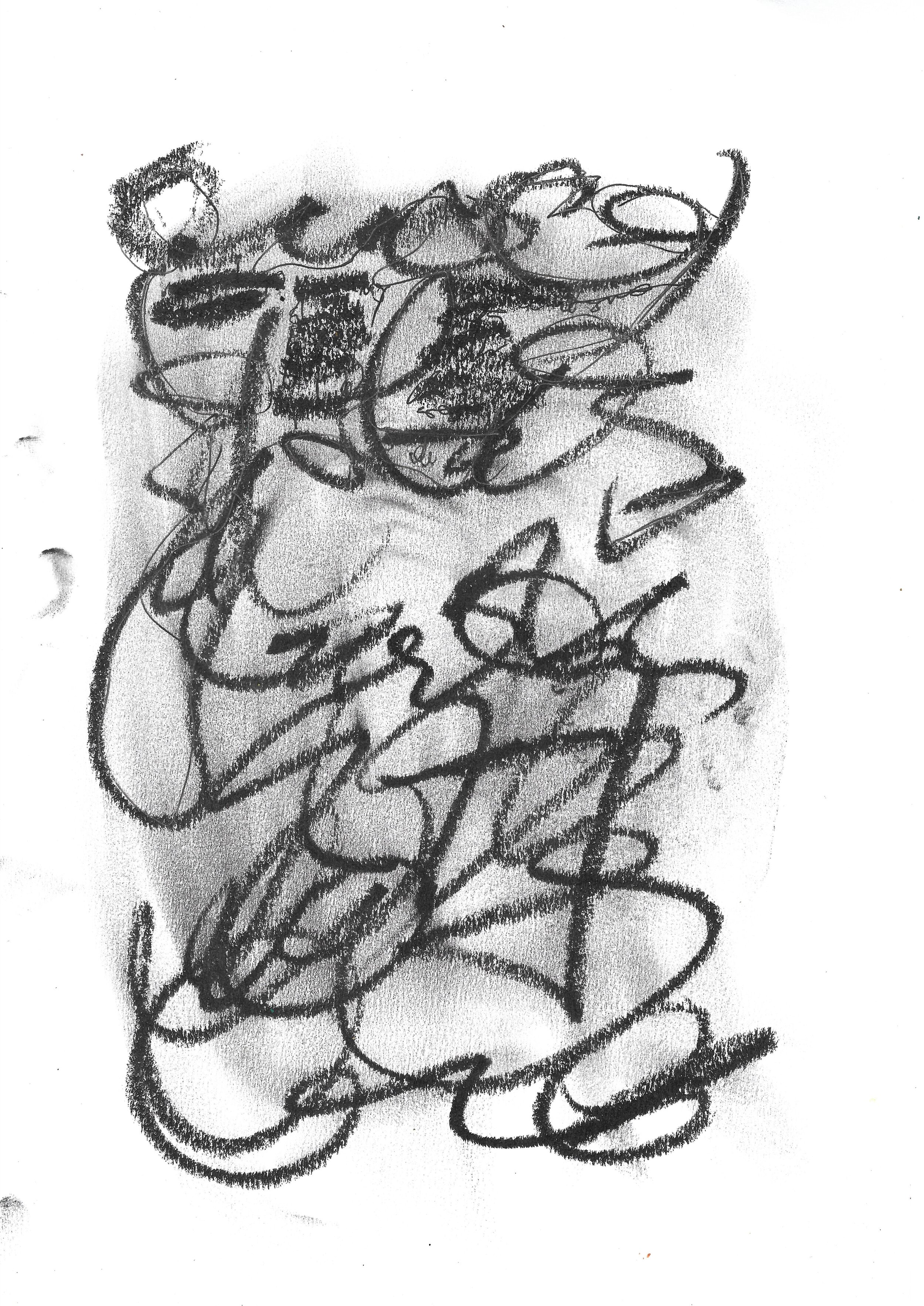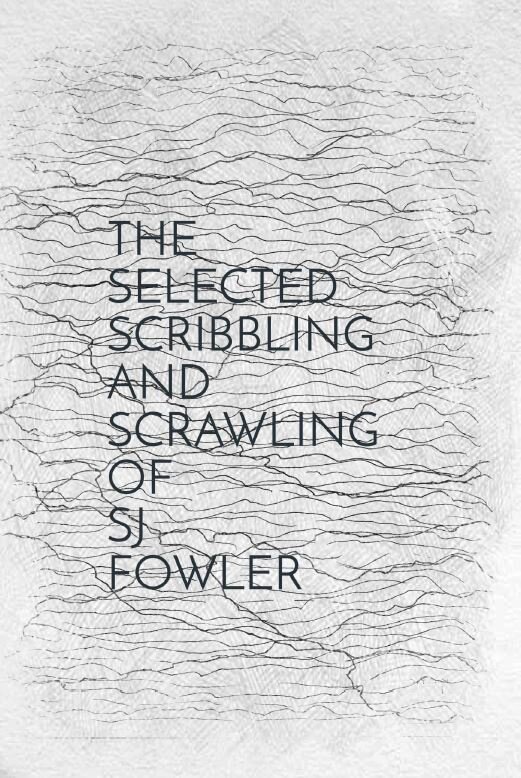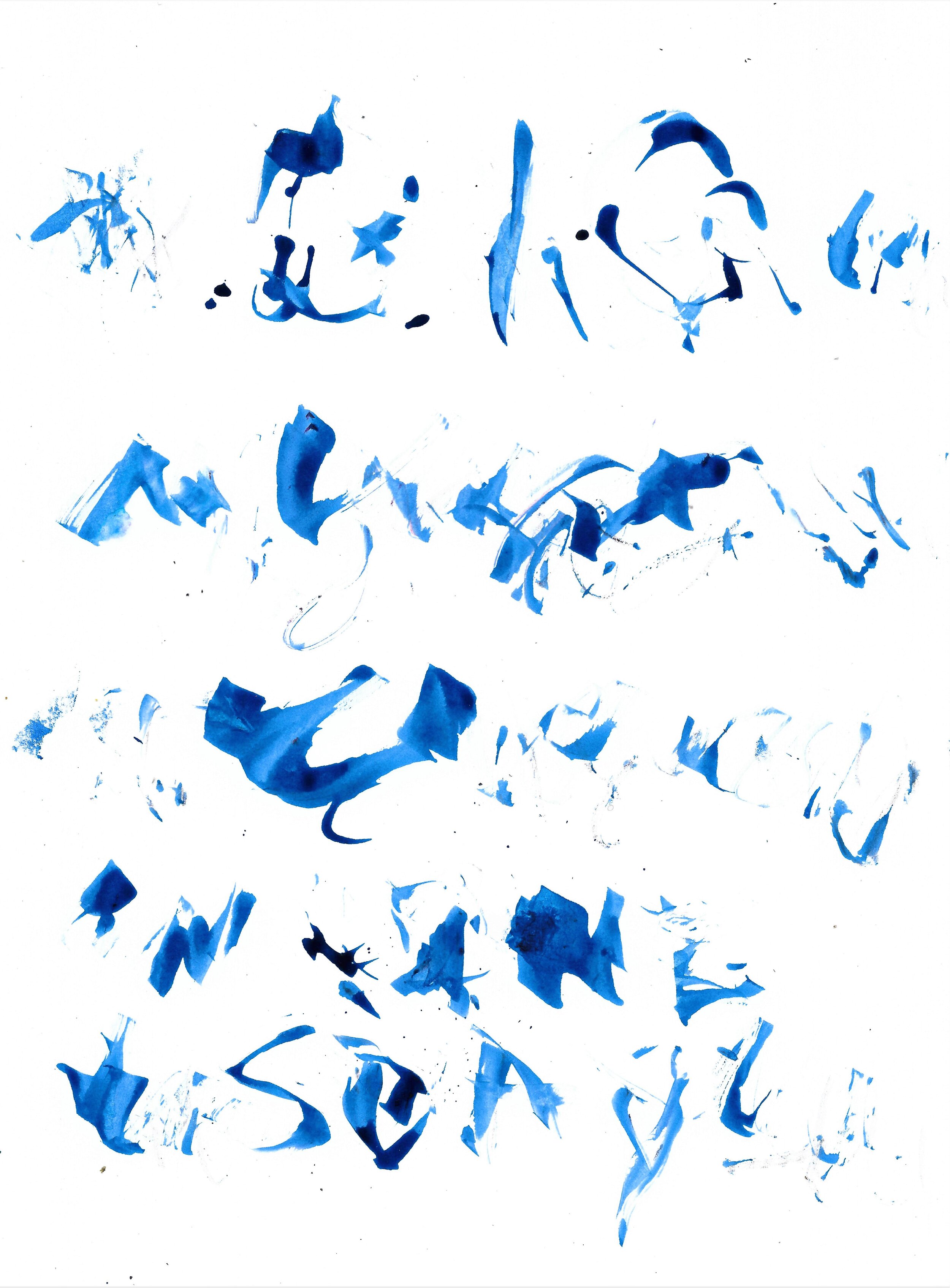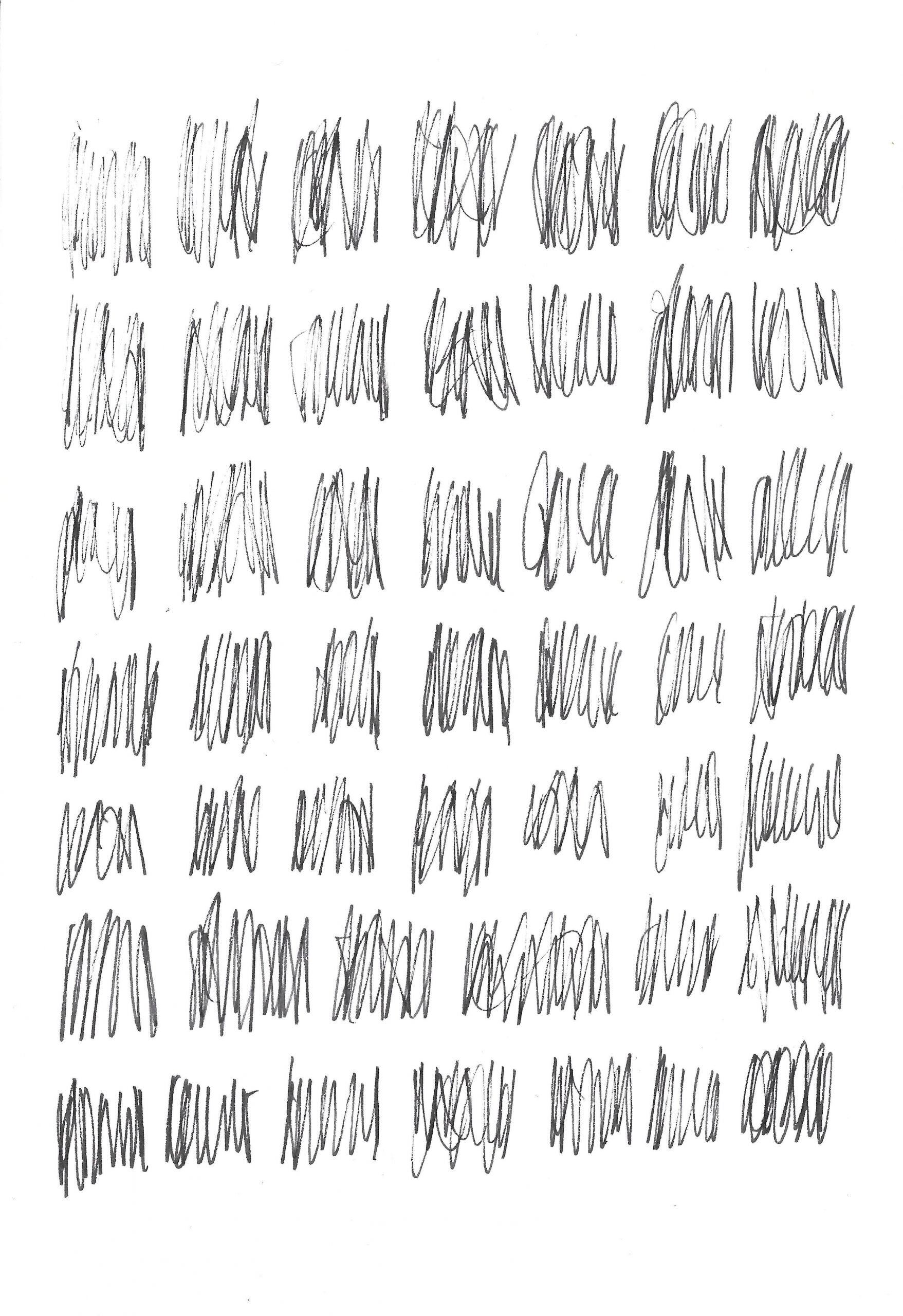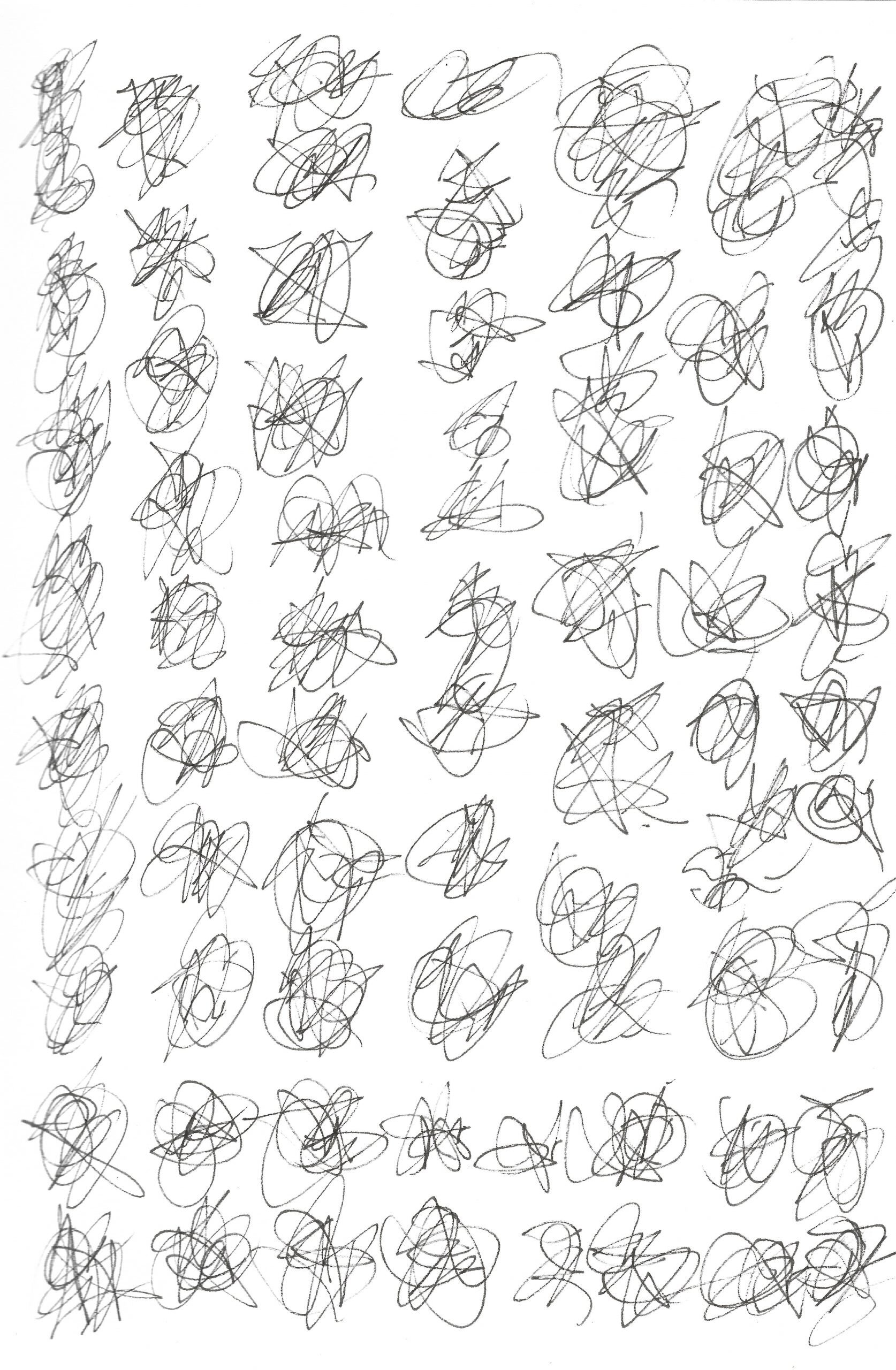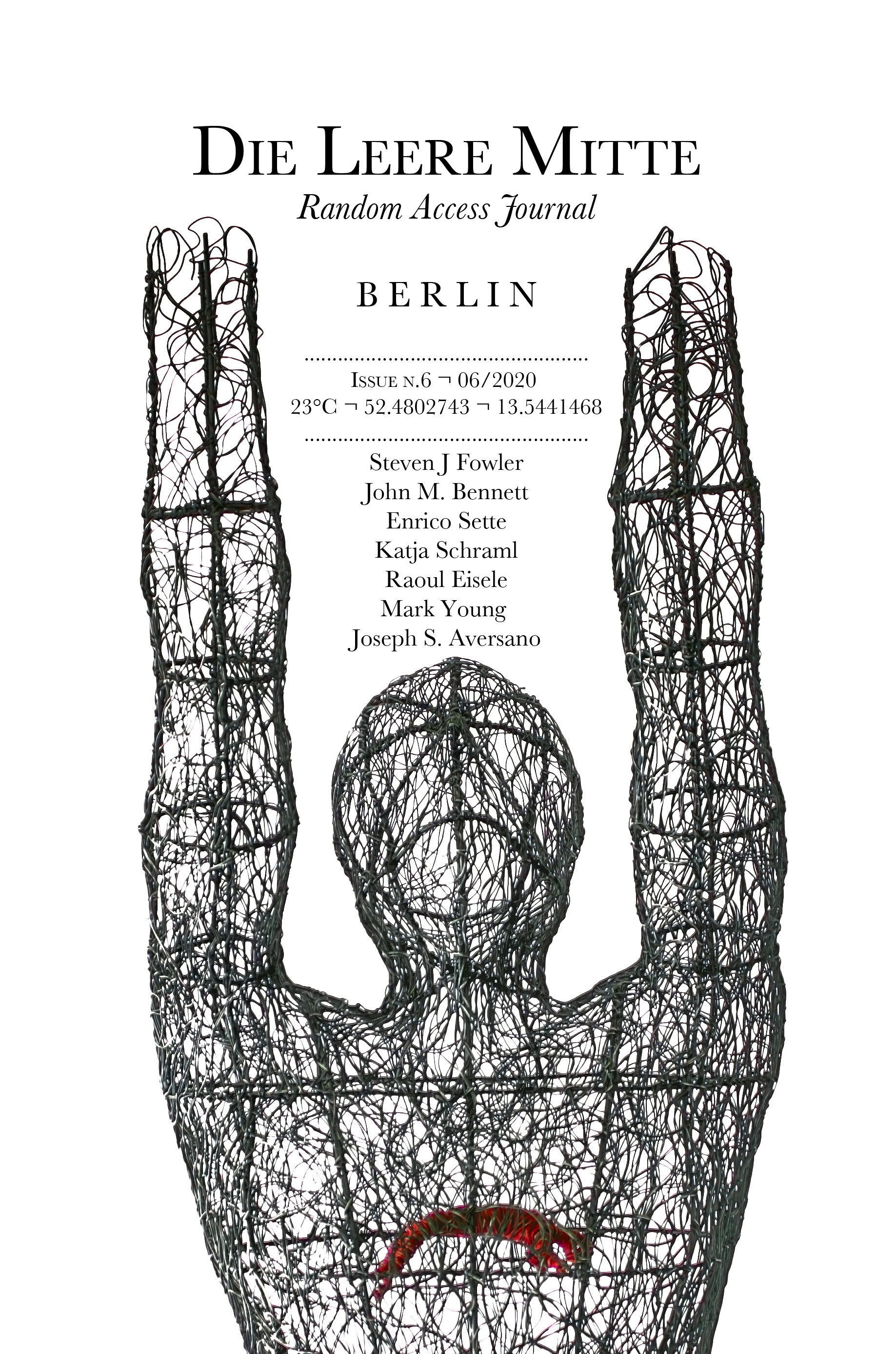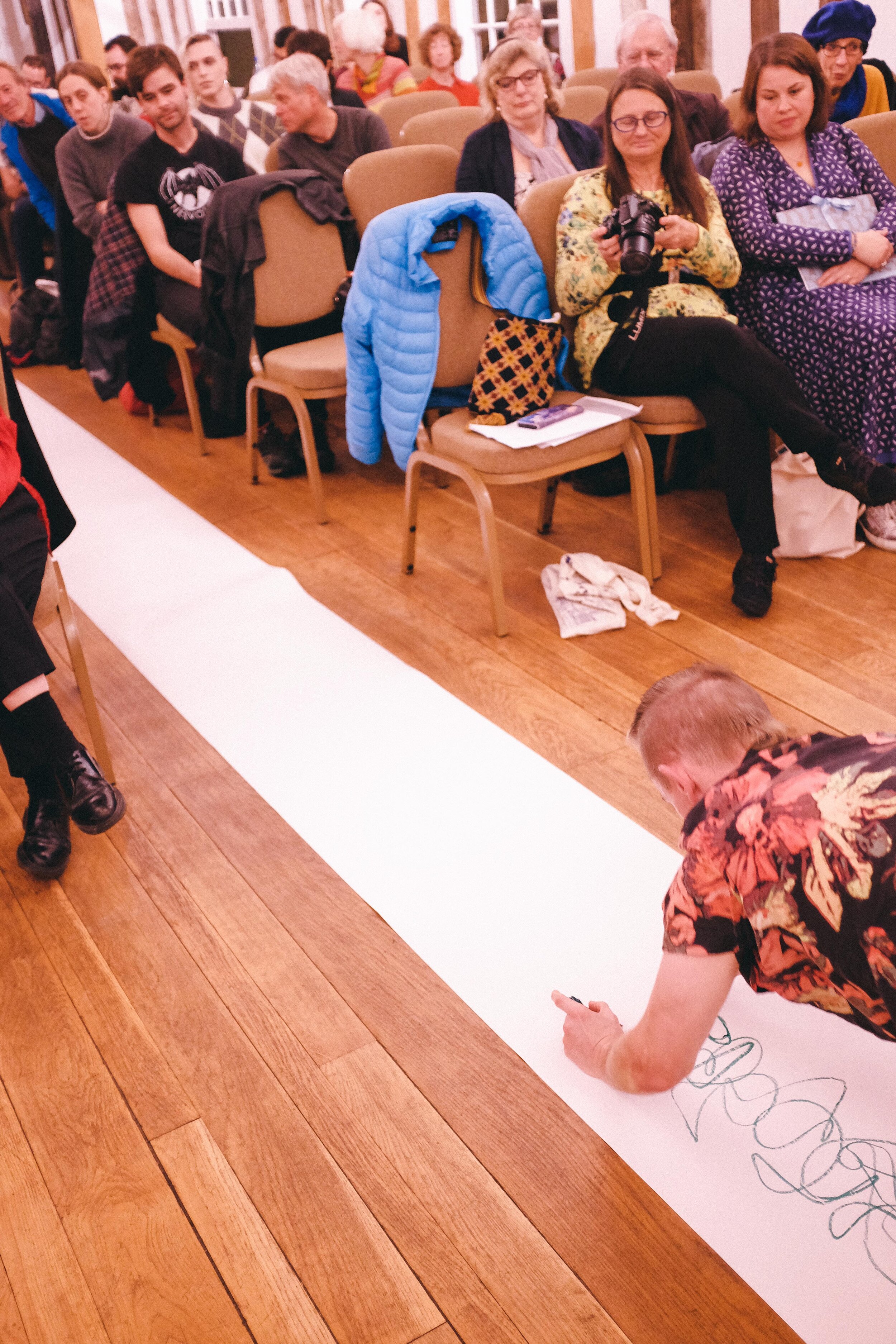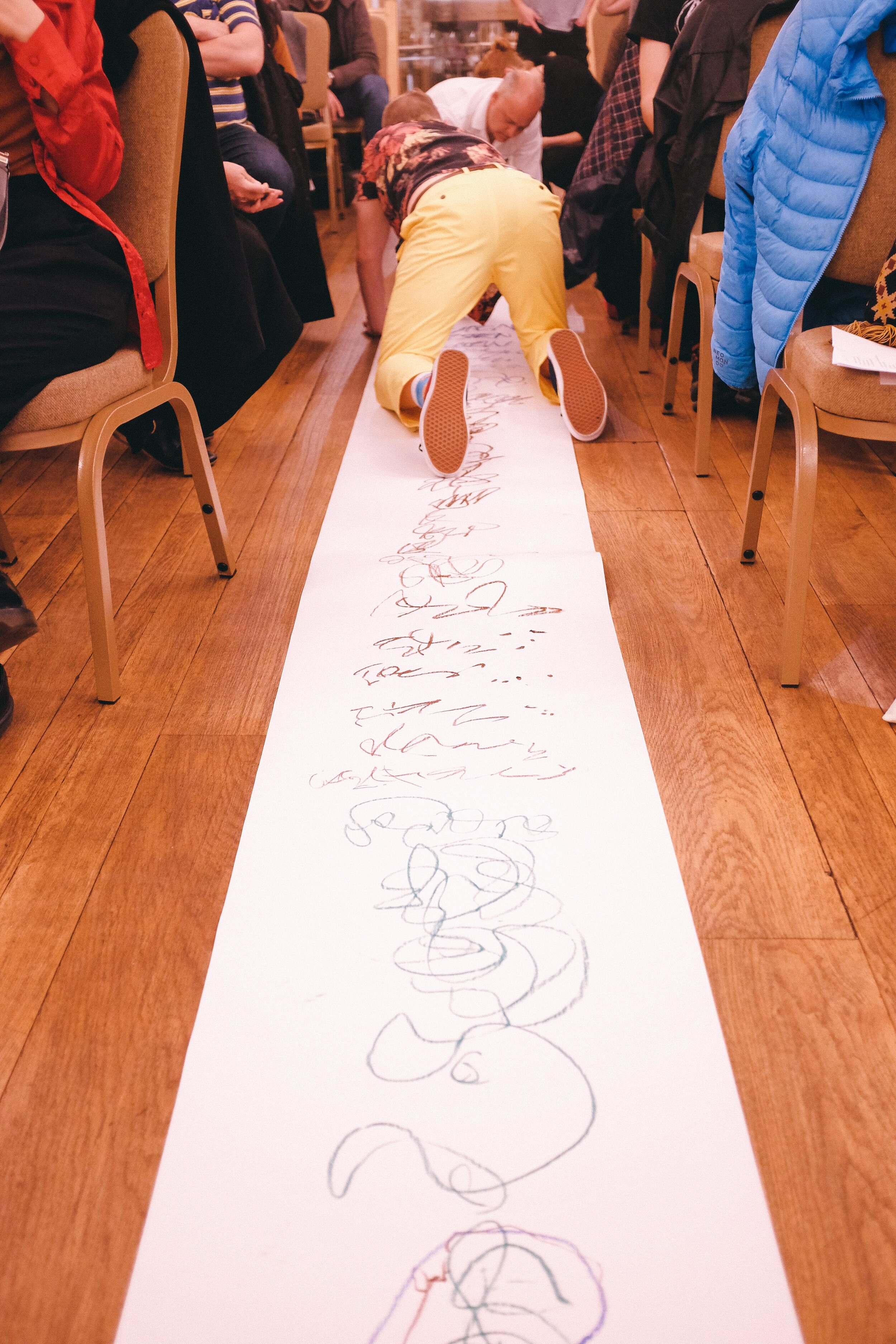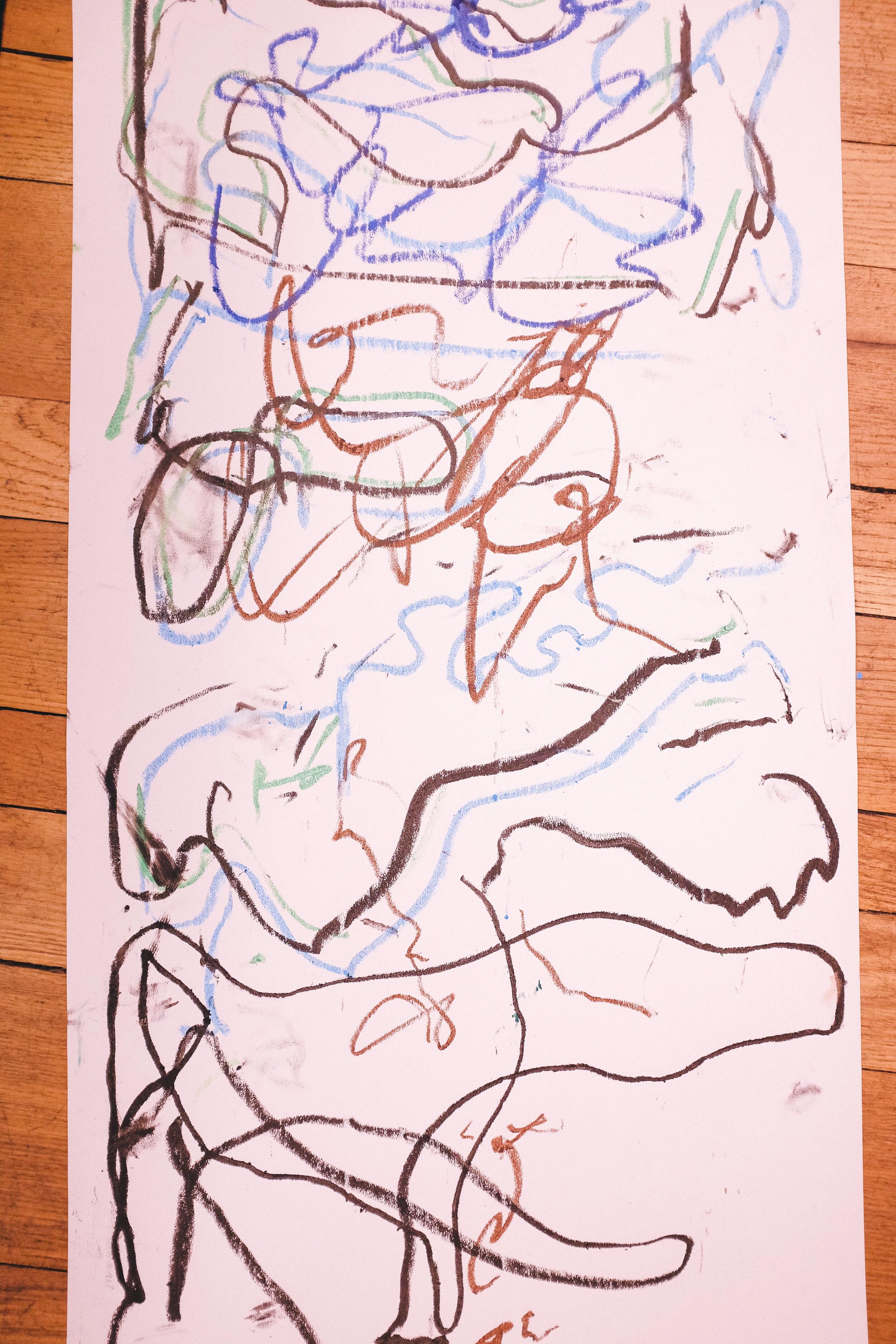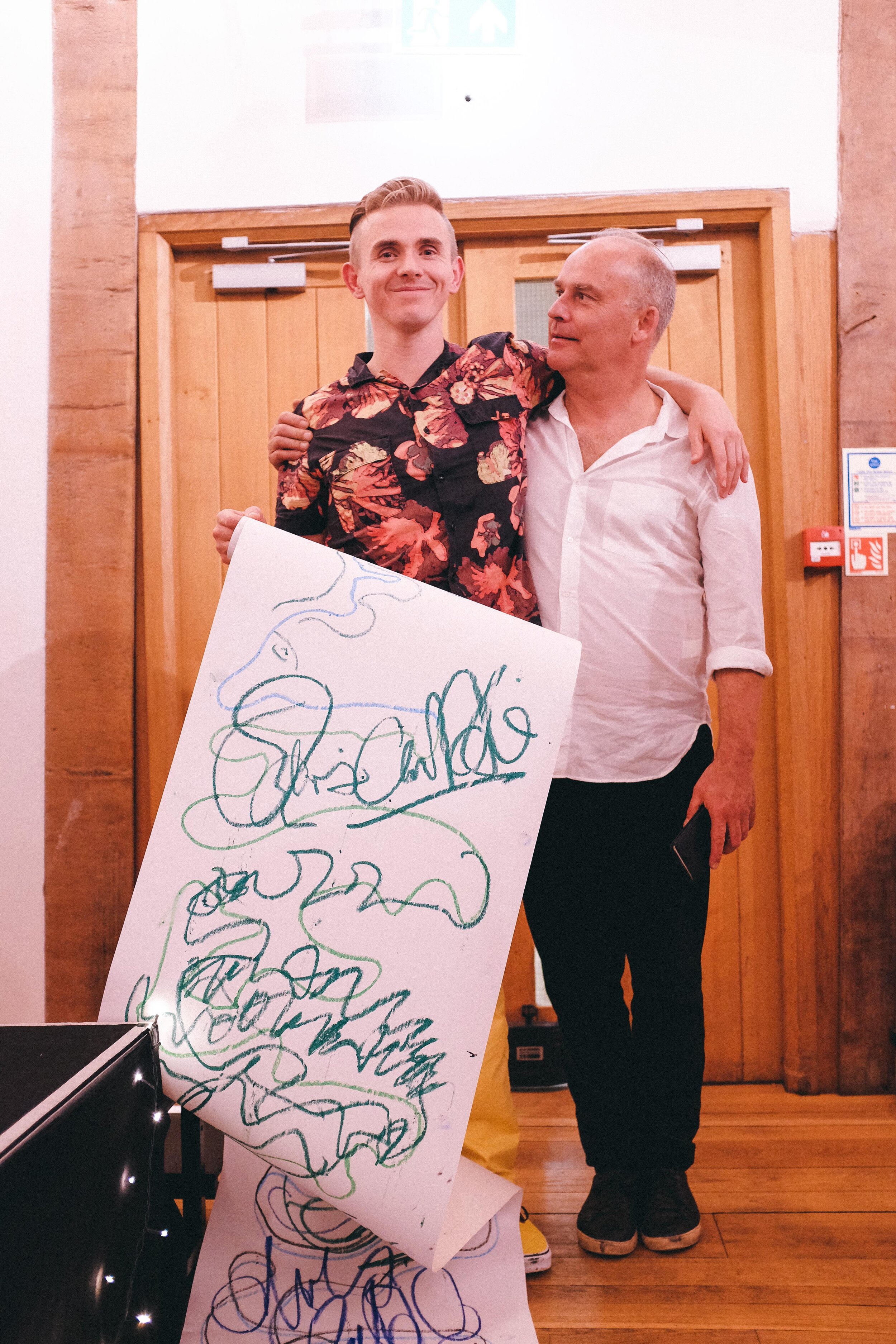Asemic Writing
After many years of publishing, performing and teaching asemic poetry, being one of the first to share this kind of literature in the UK, the Arnolfini Gallery and the Centre for Fine Print Research commissioned this talk in 2020 >
The same year my selected asemic poems - The Selected Scribbling and Scrawling of SJ Fowler - was published by ZimZalla press, with afterwords by psychotherapist David McLagan and Tin Gaze, creator of the term ‘asemic’.
Solo exhibitions Mahu (2015) and Pathological Pathogens, after Henri Michaux (2019), which showed work alongside Michaux’s, were both centred around asemic writing or writing art, as were my books Aletta Ocean Alphabet Empire (2018) and Unfinished Memmoirs of a Hypocrit (2019) and Crayon Poems (2020), and my work was included in the Minnesota Center for Book Arts Asemic Exhibition (2017).
For many years I have taught asemic poetry at Kingston University and for my Seen as Read online course, suggesting Asemic or Pansemic - writing without, or with all possible, semantic content - might be seen as umbrella term for certain kinds of Handwriting Art, Art Poetry, Glyph Art, Paint Poems, Cinematic Drawings, Logograms and Calligrams, and my work works with the material of language, its visual properties, its archeography (Marc-Alain Ouaknin’s term for the analysis and interpretation of words based not only on their etymological roots but also on the graphic form of letters).
Much of my asemic exploration led me to found www.poembrut.com, a major program of events and exhibitions making space for often overlooked poet-artists.
My asemics have appeared in journals such as Oxford Poetry, Jacket 2, The New Post Literate, Asemics and Otoliths.
At these links, you can find all my Exhibitions and Art Books.
And you can find my Concrete Poetry and Visual Art too.
You can read an interview with Tim Gaze at Utsanga (2019) https://www.utsanga.it/flower-intervista-a-tim-gaze/
The Selected Scribbling & Scrawling of SJ Fowler - Zimzalla 2020
This is my asemic writing book. Originally published in 2018, it will be released in a second edition in 2020, with new works, articles and interviews, collecting my Asemic work in one place. www.stevenjfowler.com/scribbling
"The scrawl or doodle is not a by-product of distraction; it is an active production of the mind when concentration moves downwards in the brain. It is the poetry of the mind’s rearguard, and it is more often a product of writing, pen in hand, than it is a visual art. So why should poetry, the language art, not have held scribbling to its chest? This volume of SJ Fowler’s collected works in the line let loose tradition attempts to return the wandering shapes of letters and words back to the front. Selected from over 1300 works spanning 11 & ½ years and touching upon asemic and pansemic writing, widely varying in tone, density, form and character, this selection of poems shows SJ Fowler’s fundamental impatience and childishness."
https://zimzalla.co.uk/051-sj-fowler-selected-scribbling-and-scrawling/
my Asemic Poetry talk online for CFPR and Arnolfini July 22, 2020
Part of a brilliant online summer festival organised by UWE’s Centre for Fine Print Research and Arnolfini, I was asked to talk about Asemic Poetry for a bit https://cfpr.uwe.ac.uk/book-and-print-summer-festival-2020/
Never easy to do it from the top of your head but that’s how I prefer to teach, obviously leaping from idea to idea but hopefully being more immediate / engaged for that leaping. Asemic work is important to me and the feedback I’ve had suggests this has bled through.
Asemic poems for Love in the time of covid August 7, 2020
Big thanks to Vaughan Rapatahana in NZ for this publication. He’s part of a project that (from the site) “offers an unprecedented opportunity for voices all over the world to share, in quality fiction and non-fiction, poetry and dialogue, art and music and more, the collective experiences of the international community during COVID.” https://loveinthetimeofcovidchronicle.com
My asemic poems are very recent, taken from my upcoming book The Selected Scribbling and Scrawling of SJ Fowler with Zimzalla Press. One is a crystal and one a landscape. https://loveinthetimeofcovidchronicle.com/2020/08/07/asemic-s-j-fowler/
Here is what I wrote for the site “i suppose, in a sense, a great deal of the experiences we have all gone through, if not the actual horrible sickness of covid itself, has been one of self-confrontation through lockdown’s pragmatic and practical limitations on our movements and space. in this sense then, i am interested in a poetry that acknowledges its inability to eloquently express inner dialogue, mood swings, clouded thought patterns, meaningless and often banal swings of feeling, and the expression of that. i think asemic, or semantically fraught poetry, gets to that. these poems are about synapses flashing and other things you can’t see but see anyway.”
The Poetry of Rearguard Consciousness on The Learned Pig : July 13th 2020
http://www.thelearnedpig.org/the-poetry-of-rearguard-consciousness/7780 A feature on the brilliant online journal, part of their Rhythm theme, edited by Rachel Goldblatt. I wrote “The scribble or scrawl is not a secondary product born of distraction, but a primary neurological output triggered when concentration moves downwards, expressing the minds fundamental rhythm of brain to hand movement. The poetry of rearguard consciousness, it is more often a product of writing than visual art. So why does poetry, the language art, not hold scribbling closer to its chest as a mediator of our internal writing rhythm?”
Asemic poem in Mellom Press exhibition "Home" July 18, 2020
Happy to have a new work in the second Mellom Press online exhibition, curated by Silje Ree. Some excellent visual works in there, worth a look, on the theme of home. https://mellompress.com/home/
My work is about where I grew up, Exeter.
The work is taken from my upcoming book - The Selected Scribbling and Scrawling of SJ Fowler : Asemic Poems - to be published by ZimZalla. The work is a 2nd edition of a 2018 book but will be greatly expanded with over 100 works in a dozen asemic chapters plus lots of appendices like interviews and articles.
Published : 3 new Asemic poems in Leere Mitte June 26, 2020
One of the best asemic journals in the world, out of Berlin, beautifully rendered, edited so well by Federico Federici, Antonio Diavoli, Nika Turbina all visible online here https://leserpent.wordpress.com/2020/06/22/die-leere-mitte-issue-6/
Three new asemic poems from me - dog’s eye / dog’s portal / dog’s shadow monster
This is a link to the issue directly also https://ia601500.us.archive.org/34/items/dlm6_20200621/Issue%206.pdf Cool to be in there alongside John Bennett too, a legend.
Two pansemic poems on Asemics.com April 25, 2020
Grand to have two new figurative pansemic poem artworks published on Asemics.com
Eye of There’s Nothing http://asemics.com/eye-of-theres-nothing-steven-j-fowler-uk/
Eye of the Wave and Foam http://asemics.com/eye-of-the-wave-and-foam-steven-j-fowler-uk/
Three Asemic Poems on JACKET 2 : EXTREME TEXTS with commentary - 2019
jacket2.org/poems/atrocita-sphinxe-and-your-own-double-entry
“Extremity is relative. The furthest thing from a given point, which is relative and changeable, cannot escape the tether of that stake. To some, within tradition, at the most surface level, any unusual gesture is severe. If one’s goal is to seek control over the uncontrollable, any submission to the unruly is a threatening gesture. If one has accepted that there is no control possible, only mediation, then only the fundamentally transgressive is extreme, because it touches on the opposite of life. All this begins within the human mind, not the poem, the strange secondary barrier of language that emerges, faulty and failing.”
Nordic Poetry Festival - a Crayolasemic performance with Morten Søndergaard at National Centre for Writing : October 18, 2019
Morten Søndergaard is beloved. A man as generous and brilliant as he is gracious and kind. He and I worked together back in 2013 and we’ve maintained a friendship since then. Our work on this night was put together with almost no deep discussion. One idea led to another so quickly, so easily and we were experienced enough to leave so much to the improv energy of the night. Our mini dialogue played out as we unfurled our wallpaper and crayon asemic wrote to and around each other. I’m quietly proud of this work. / Pictures below by Alexander Kell.
Poethetic Pathogens, exhibiting next to Henri Michaux
Avivson Gallery : February 2019 www.stevenjfowler.com/pathogens
Five new paint or asemic poems exhibited alongside, and responding to, an original work by 20th century poetical iconoclast, Henri Michaux. I'm pleased to announce this week long exhibition at the Avivson Gallery in the heart of Highgate, London. From the gallery “... Fowler’s work has become synonymous with a new generation of European poets following Michaux’s explorations into writing abstraction and handwriting art, and the possibilities of a more instinctive notion of what literature might be. The Michaux work in question evokes the microscopic bacteria that permeates our bodies beyond our sight, and it is this visible but unseen aesthetic that Fowler has pursued in his artworks.”
A wonderful opportunity for me to exhibition at Highgate’s Avivson Gallery for just over a week this month. My exhibition consisted of new asemic poems, blotchpoems, responding to an original Michaux centred on the walls. We had a powerful opening night and I invigilated for a few days too, with posh people and weirdos coming in to peruse my inks and ask what they were? I tried to change my answer everytime. Midochlorians, mitochondria, pathogens, people, abstracts… The real joy was beginning the relationship with the gallerist Janus Avivson and his colleagues. Amazing people, generous and dynamic and completely unique. I hope it’s not the last time I’m in this space, one too rarefied for my dirty work.
One Asemic Poem on BERFROIS (2019) www.berfrois.com/2019/06/no-one-really-understands-me-sj-fowler/
Seven Asemic Poems on OTOLITHS (2011) the-otolith.blogspot.com/2011/03/sj-fowler.html
Four Asemic Poems on ASEMICS (2018) asemics.com/4-asemics-by-steven-j-fowler/
Three Asemic Poems on THE NEW POST LITERATE (2016) thenewpostliterate.blogspot.com/2016/10/3-excerpts-from-forthcoming-book-aletta.html
Calligramms with Penteract Press 2019
The only thing I’ve released that can be enjoyed by human animals of all ages. The brilliant Penteract press, who have been carving out more appreciation for formal and visual poetry over the last number of years, have released a selection of my animal Calligramms as a pamphlet. It’s beautifully produced, very delicate and elegant, a fold out document. It can be bought here https://penteractpress.com/store/calligramms-sj-fowler
“‘The Calligrammes are an idealisation of free verse poetry and typographical precision in an era when typography is reaching a brilliant end to its career, at the dawn of the new means of reproduction that are the cinema and the phonograph.’ (Guillaume Apollinaire, in a letter to André Billy)
‘Animals are cute when they're not real, and my calligramms are forgeries.’ (SJ Fowler in a letter to Anthony Etherin) .”
Hard to Read : Exhibition at Rich Mix Gallery - 2017 / 2018
Collected Paint Poems, Pansemia, Cinematic Drawings and Logograms
From the gallery "Collecting together the art poetry of SJ Fowler, this solo exhibition aims to pose several questions of the poem as a concrete, visual thing in the world. What is in the shape of a letter and what images do words recall? What is the meaning of colour in poetry and text upon the page, and white space? How does the situation of a poem change its meaning? Why is composition not a concept that applies to a medium that is innately visual? In literature, why has content overwhelmed context? Why has product dominated process? HARD TO READ poses these questions and answers them poorly, playfully, with over 40 original works drawn from multiple publications and previous exhibitions - works that interrogate handwriting, abstraction, illustration, asemic and pansemic writing, scribbling, crossings out, forgotten notes, strange scrawls - the odd interaction between paper and pen, and pencil, and coloured words that randomly collide with image recalling words. This is an exhibition about the page as a block, about geometry, about lines that sever meaning, about inarticulate shapes, about minimalism and collage. It is about making, gesturing towards the handmade poem, the amateur poet, the outside, liquid and paper, the absence of technology, and ugliness - toilet wall draughtsmanship and mess. It is a response to being called an artist in the poetry world, and a poet in the arts world."
Aletta Ocean's Alphabet Empire Hesterglock Press : 2018
A book of visual poetry, art-poems, abstract paintings, asemic writing and illustrations, all in black indian ink. A book on pornography and disembodied sex. www.stevenjfowler.com/aoae
From the publisher - A book that asks, abstractly, are letters shaped like bodies? Can words evoke faces, captured in a screen? Who, or what, is assimilating, who or what? Aletta Ocean's Alphabet Empire is a collection of art poems, hand wrought in black, grey, silver and white, fashioned with indian ink, paint and pen, worked with techniques that edge around writing, vying with abstraction, constantly harrying semantic meaning and legibility. A book about sex, poetry and pornography and the disconnect between the former and the latter. These pages explore technology in its absence and aim to evidence the power of materiality and the body, and our hands, that are still required for touch."
Mahu : Hardy Tree Gallery (2015)
www.stevenjfowler.com/mahu My first solo exhibition in London ran for five weeks in the Hardy Tree Gallery, in Kings Cross, just behind the British Library. Mahu was an exhibition of writing - a novel written upon the gallery walls, growing as the exhibition passed. A living book in ink, veering between sense, story and abstraction. The gallery was covered in scrolls of paper, onto which I wrote, without preparation and entirely within the gallery. As the exhibition passed, so the walls became entirely covered. The text will never be typed, only read, ready to be unfurled.
There was a series of events during the exhibition and one, A World Without Words, featured the below discussion with Lotje Sodderland, whose use of asemic writing, without knowing what it was, was part of her recovery from a stroke and the rediscovery of language. Her experiences were a beginning to my own exploration of the neurological element of handwriting art and abstract writing techniques.
writing the intro to Federico Federici's Pithecanthropus Erectus... July 31, 2018
This is a beautiful book of brilliant visual poems by one of Europe's most interesting writers. I was very happy to be asked by Federico to write an introductory text for the book, not so much a traditional lead but a creative text that opens the book. Federico has accurately described his work as a asemic note/sketchbook based on Charles Mingus' Pithecanthropus Erectus masterpiece. I highly recommend you buy it here https://www.amazon.co.uk/dp/024499904X/
"The work is remarkable precisely because it works in a graceful, familiar space to do often stark and unfamiliar things. Like jazz that absorbs sound. This feels to me a faithful act towards listening and the intention towards possibility and inspiration. The roll, the smudge, the dead signature. The cut in the scrawl. The squig. The line, cards and bled ink. Sounds on paper." - SJ Fowler http://federicofederici.net/libri/
Asemic Exhibition in Minnesota
February 2017
Asemic Writing: Offline And In The Gallery: an Asemic Writing exhibit at Minnesota Center for Book Arts opens March 10th and runs till May 28th 2017. Curated by Michael Jacobson, this exhibition basically brought together most of the world’s foremost practitioners of asemic writing in one place.
http://thenewpostliterate.blogspot.co.uk/2017/02/asemic-writing-offline-and-in-gallery.html
Featuring Asemic Writing & Book Art from: Tim Gaze, Rosaire Appel, Luigi Serafini, Carlos M. Luis, Israel F Haros Lopez, Paul A Toth, Alain Satié, Jose Parlá, John M. Bennett, Marco Giovenale, Cecil Touchon, Scott Helmes, Derek Beaulieu, Brion Gysin, Satu Kaikkonen, Cheryl Penn, Raymond Queneau, Logan K. Young, Steve McCaffery, Xu Bing, Geof Huth, Max Ernst, Timothy Ely, Charles Stein, Gazaliel, Lucinda Sherlock, Volodymyr Bilyk, Catherine M. Bennett, Henri Michaux, Jim Leftwich, Michael Jacobson, Francesco Aprile, Bill Beamer, Nuno De Matos, Lynn Alexander, Tony Burhouse, Scott Ross, Axel Calatayud, Henry Denander, Jean-christophe Giacottino, Lin Tarczynski, Tom Cassidy, Ricky Brett, Edward Kulemin, Phil Openshaw, Kerri Pullo, Anneke Baeten, Benji Friedman, Laura Ortiz, John McConnochie, Kimm Kiriako, Sam Roxas Chua, Steven J Fowler, Tatiana Roumelioti, Ekaterina Samigulina & Yuli Ilyshchanska, Nico Vassilakis, the unknown author of The Voynich Manuscript
Asemic Poem in Oxford Poetry September 23, 2016
Grand to have this art poem, on the left page, in the latest issue of Oxford Poetry. Thanks to Lavinia Singer and the editorial team at OP, which has been publishing since 1910. The work will be featured in my debut art book, published by Stranger Press in 2017, called I fear my best work behind me. This is what I wrote to contextualise the poem... http://www.stevenjfowler.com/blog/2016/9/23/published-an-artpoem-in-oxford-poetry
"The poem on the page is first a series of markings made upon a surface. Obvious, but it seems to me a great source of often profoundly underexplored potential for the poet. That is the continued realisation of this fact - of black on white, of colour, material, front, handwriting, of dead and living space, of a computer screen or piece of sliced tree - all that is happening aside from semantic content, and the relation of these things in changing, fluctuating, the semantic meaning and content the poet should worry over.
This work draws from the influence post-war central European avant garde pioneers like Henri Michaux, Christian Dotremont and Constant Nieuwenhuys have had on my work, all of them poets in the purest sense, all too erroneously and conveniently labelled artists. It draws on asemic writing, experimental logograms and illustration but it also a poem in the clearest, anthropomorphic sense"
And from the editorial ... "Encrusted in paper word impasto, this issue of Oxford Poetry celebrates the relationship between the verbal and the visual. Some poets respond ekphrastically to works of art (Richie McCaffery, Jeremy Valentine Freeman Ganem, Pascale Petit, Nancy Posey). Others paint worlds through bold metaphor and surreal imagery (John Burnside, Rebecca Perry, Mark Waldron, Astrid Alben, Martha Kapos) or evoke the subtleties of consciousness, memory and perception (Dominic Hand, Fiona Sampson, Denise Saul). Others step into the realm of visual poetry (SJ Fowler) to shape their words on the page (Chris Kerr, Elaine Feeney)." http://oxfordpoetry.co.uk/
Diamanda Dramm uses my Asemic Writing for live shows : 2018 - 2019
My Asemic Writing projected onto violinist Diamanda Dramm for her shows in Holland and Indonesia across 2018 2019. http://www.stevenjfowler.com/blog/2018/11/29/a-note-on-in-amsterdam-to-watch-diamanda-dramm-a-timeline-of-our-collaboration
Lex Icon published my calligram Puffer / 2012
http://lex-icon21.blogspot.com/2012/05/lex-icon-blog-project-post-50-steven-j.html
"The conceptual brilliance, and historical prevalence, of the calligram need not be overstated, and though forms like square kufic have influenced me, it is Apollinaire's calligrammes which have inspired me, as they have many others. However, the calligram has always attracted me first and foremost precisely because of the illegibility of the handwriting! It allows for multiple readings of the text as well as of the image. Thus I have been faithful to this notion, and though the poem hidden in this fish is indeed real, it is determinately vague."—Steven J. Fowler
Intervista a Tim Gaze by Steven J. Fowler - Utsanga Magazine 2019
1 considering the variety of styles in Selected Scribbling and Scrawling, do you create in waves of similar work? Do you deliberately
try not to repeat yourself?
I think I’m trying to consider the method of scribbling or the mode of scrawling, the hand-line, as an entire form, or creative universe. Something that is not an adjunct of poetry or text art but a way of making poems that one might spend a lifetime refining. I’d like to teach a course on scribbling. It would be more therapeutic than one about writing poems. So the selections for the book are from different periods of time, where differing concepts were prominent in my writing and so absolutely your question is well considered, these are bursts re-ordered, re-considered post facto. My favourite works are the intricate scribs, done usually on trains in London, with an hour journey given to each line, and then reworked over weeks. But others were done walking in Gdansk, upright with my eyes closed, for example.
2 how did you get into making things which are completely left of the
field of vision of many readers who think they’re into poetry?
Pure chance, no childhood influences, parents who still don’t know what poetry is, working class people who didn’t even read for pleasure, and then in my early adulthood, randomly. This is the greatest gift to me, that I was already a half formed human before considering what poetry is and what it isn’t. And that I am still, 9 years in, plagued by questions unasked by most in the field but still strange and unanswerable to me. For example, surely, to separate poetry from text or conversation or opinion or prose or fiction, a poem needs only be language referent and then to seeking an answer to a self-situated paradoxical question. A poem aims then to be stating or saying the inexpressible. This seems the beginning of the medium to me. Why would just say something in a poem if we can say it anywhere else? Anytime, in any language chunk, any conversation? Advertising does this, speeches – why poem at all if one is going to state or lecture? From this comes many hundreds of natural follow up questions. Why are almost no poems published handwritten? Is there no meaning in the handwritten letter? Only if letters and words are secondary to emotion and opinion. But if this is the case then why poem? I bore myself saying this stuff.
3 is there an ideal reader who really “gets” what you’re doing, or is any response a good response?
Definitely the latter. I hope for negative aesthetics and so negative reactions, as we need to allow for that in what we’re doing, and I wouldn’t ever presume to know the endless strange idiosyncratic contents of another mind and therefore what they might think of the irrelevant doodles I throw out. That they respond at all is all.
4 have you shown your work to people who can read other writing systems: Chinese, Korean, Arabic, Hebrew & so on, & had any interesting reactions?
By accident. I don’t share my work with my students but some of them have picked up these asemic / poem brut books, and many of them have knowledge of logographic languages. Moreover, away from my own work, I include Arabic writing art and Chinese calligraphy in my poetry course at Kingston University. Contemporary poets like Adonis, Wang Huaiqing, Tan Ping, Leah Lihua Wong are exciting for the students but it’s also a way of me making a case for the history of abstract poetry practise across the world, and relating it specifically to language cultures. Zhang Xu, square kufic, lost manuscripts, undeciphered languages – this kind of exploration has influenced me for sure. I worked for seven years at British Museum, it’s had a knock on effect in my thinking.
5 expanding on question 2, do you remember the first scribble you deliberately made, & what made you decide to do it?
This is a difficult question to answer. As is often the case, the answer might be equally truthful when given pragmatically as well as perhaps more introspectively. I was undoubtedly copying someone, probably Henri Michaux or Christian Dotremont. I found it way after I started actively Scribbling, that is being aware I was doing it, seeing it as a poetry, but David Maclagan’s book Line Let Loose: Scribbling, Doodling and Automatic Drawing was a moment of concrete realisation for me. I found it in Wellcome Library, where I was doing a residency.
More introspectively, if there’s two things I realise I’m trying to do in everything I make, but most especially asemic poetry and scrawling art, it’s to embrace of the paradox of the process. That it is mysterious and instinctual and yet I want to formulate it, maybe just cognitively. Be aware of what I’m doing right up unto the moment I’m not. Secondly, be on my own path. Accept that not being herd-like in one’s creative mentality, in poetry and art, like in life, means accepting your work is the result of a vast conglomeration of strange influences and ideas, that you then, and I say this hopefully without its implied melodrama, refuse to make more palatable, if indeed it’s not. When these strange internal ideas mingle, and then meet the weird instinct of making, I just try to then not think of others, just let the mash fall where it may. With the scribbling pieces this is so immediate, so obvious, because it’s something defined by its ephemerality, its association with children or lack of concentration or attention in the ‘normal’ mind.
6 colour is used differently in Aletta Ocean’s Empire, I fear my best work behind me & Selected Scribbling & Scrawling. Also, the works in each book seem to have been made with different materials. Are they delvings into different states of mind?
This was quite definitive to me, but I only realised after the making of each book how much so. I had no understanding of colour. I have no formal artistic training, or creative training of any kind. So I had to think through colour, had to research. And naturally I felt like I was always going to be negotiating my own ignorance and lack of general skill and knowledge. Again on instinct the books took on differing characters, because of what I declared they were about. Aletta being about sex and pornography and I fear being about time and anger, the concept of calming, and scribbles being about memory and consciousness. This then informed my choice of materials, where I made the books, and then how they were edited down from many works, until they had, retrospectively and definitively, a sure cohesion. I’m not sure I had different states of mind, but intention for sure, and the works from different books were not made ever on the same days.
7 are the works in some books slower to make & possibly for a reader to read than others?
I believe this to be relative to the reader. Some are inevitably more detailed and so are about that detail, perhaps an ironic nod on my part, knowing how generally talentless, impatient and untrained I am, that these are the works with the tiny note of skill, or investment, which I know pleases a lot of people, in their stomachs.
8 what books do you have currently in production, & what kind of work will they contain?
I have just had a thing out with the brilliant Penteract Press, a small fold out of calligrams, made for kids I suppose, of animals. Later this year I have another clearly Brut book out with Hesterglock press, entitled Memmoirs of a Hypocrite, about Spain, Stendhal and bread coloured paper. I am coming close to finishing a book entirely created with crayons too.
9 is there a network of poets, publishers, galleries & so on, sympathetic to your kind of work?
I think so. I think I’ve tried to inculcate one with the live events I’ve run under the Poem Brut banner www.poembrut.com and certainly some amazing folk like Michael Jacobson have been in touch from North America. In Europe, where so much of my interest is, this kind of work seems to have a completely different standing and understanding. I’ve found so many poets there who would shrug at the notion of this kind of hand-aired work being unusual. And from my open call for poem brut work on 3am magazine I’ve had poems sent in from across the globe. Everywhere from Angola to India to Japan. And I get around 15 works sent in a day. It’s a global community.
10 do you have kindred spirits from the past & present?
Henri Michaux has been a terrible influence on me, in so much as I can’t escape his shadow. I’m actually doing a short exhibition in London where a small series of my works will be exhibited alongside one of his original works. It’s a literal kindredness. His balance of humour, exploration, literary chops alongside art concepts make him something utterly unique and important to me. But I’d also throw nearly all of the CoBrA group into this spirit world. And many others known primarily in the visual art world.
11 is there anything you’re working against?
An interesting question as it knowingly implies a negative framework. There is, absolutely, but also not seriously. I’ve done loads of thinking to try and move myself away from this mindset. I try not to work against. Though righteousness and intellectual reductiveness is something I’m trying to find a way to confound in tiny miniscule shadow moments, I suppose. But with scribbles? I’m failing, so I’m trying not to go against anything.
An interview with Marco Giovanale (2011)
https://www.3ammagazine.com/3am/maintenant-65-marco-giovenale/
3:AM: How did you begin your work with asemic writing? Was there a practitioner who influenced you especially?
Marco Giovenale: I’m not sure I can actually figure a year or period I can define as the starting point of my asemic activity in general, also because I have also been a (bad) painter and I made a lot of (not so bad) drawings too, in the 90s: some of these ones were abstract charcoal pieces or ink scribbles, my personal prehistoric asemic writing. In fact, I’ve invented the verb “to drawrite” (to draw + to write), to give a name to my activity.
